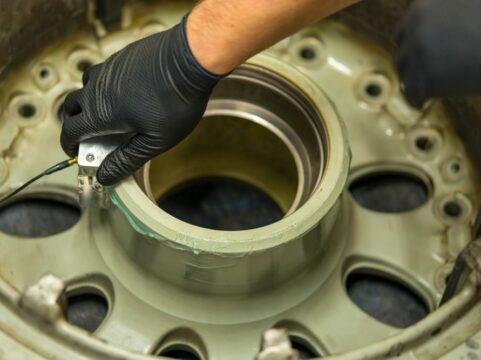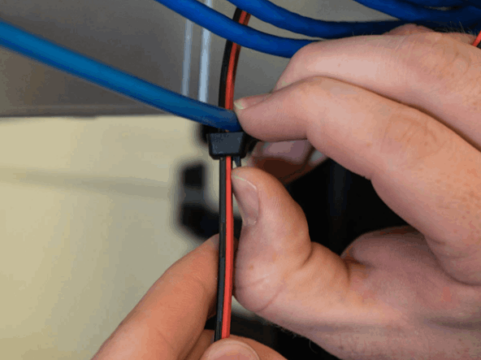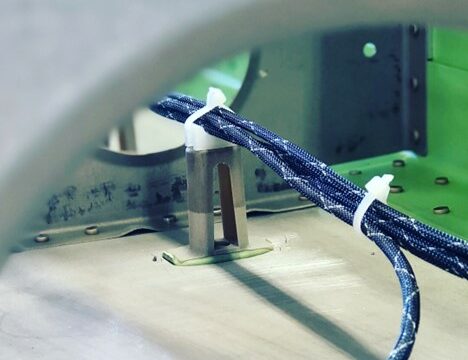Cable Tie Vs Grip Lock Ties: Which is Right for You?
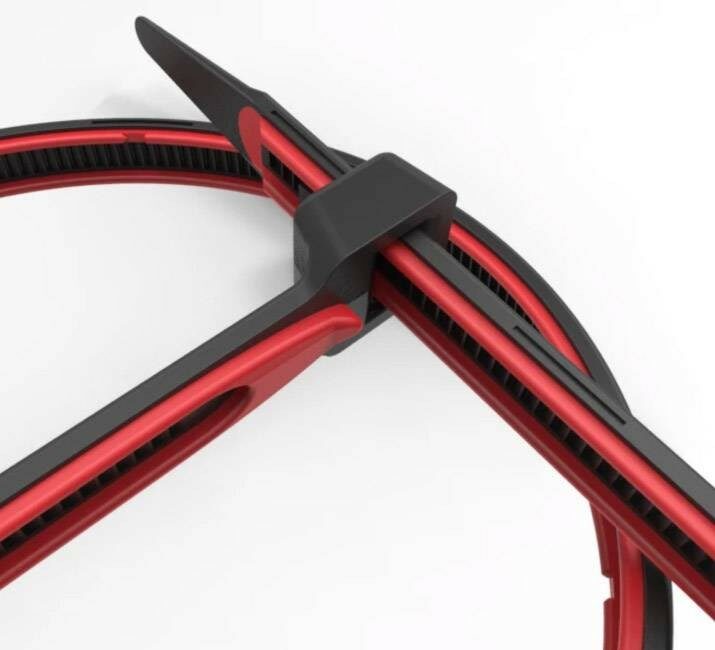
- February 06th, 2025
- Categories: Uncategorised
You’ve probably heard of a cable tie mount before. It’s hard to break or cut, but it’s a great way to keep wiring organised.
Grip Lock Ties, on the other hand, are dozens of times stronger and critical to heavy-duty applications in defence, aerospace, industrial, military, and many others.
This blog will draw detailed comparisons between cable tie mounts and Grip Lock Ties so you can decide what is best for your project. After all, strength in the field of defence is non-negotiable.
Understanding Cable Tie Mounts
Does your working environment involve a lot of electrical wires? Invented and patented in 1958 by Thomas & Betts in the U.S., cable ties were originally introduced under the brand Ty-Rap, which was invented for aviation use. This self-locking zip tie was similar to the ones we see today, but it was made from stainless steel. It transitioned to plastic and nylon in the 1970s.
Also called zip ties, cable tie mounts make things easier to maintain by bundling wires together and keeping them well-organised.
This includes a head that provides a slot to be pulled through (and to create the desired loop) when threaded through the slot. The teeth form a locking mechanism that is very difficult to pry open!
Commonly used in computer, network, and entertainment setups, cable tie mounts can be made of plastic, rubber, Velcro straps, or nylon, which is the most common choice. Some types of cable ties include:
- Standard: These feature a one-piece, self-locking fastener and a single-use design that can handle bundling demands.
- Releasable: Usable more than once, releasable cable ties feature a lever or button that takes a large amount of force.
- Mounted head: With a mounting hole design, the mounted head allows the cable tie to be fastened by a screw so it can be fixed to a vehicle panel, chassis, or wall.
- Push mount: The in-built mounting part of the tie can be inserted into a pre-drilled hole and locked into place.
Advantages of Cable Ties
- Cable ties bundle and guide cables easily in conjunction with different cable ties for different bundle diameters. They can be installed without screws, rivets, or drilling holes.
- Where it isn’t possible to route cables, self-adhesive cable mounts can be used to drill a hole, use an edge clip, set a weld stud, or where it is too expensive or time-consuming.
- Bonds well on low-energy surfaces such as PE, PP, metal, varnish, or paint and is suitable for vehicles and machinery. Excellent for cable installation in gaming machines, computer systems, or domestic applications.
Although they are self-fastening and almost indestructible, cable ties solve a complex problem, but there is a stronger version of cable ties: Grip Lock Ties.
Exploring Grip Lock Ties
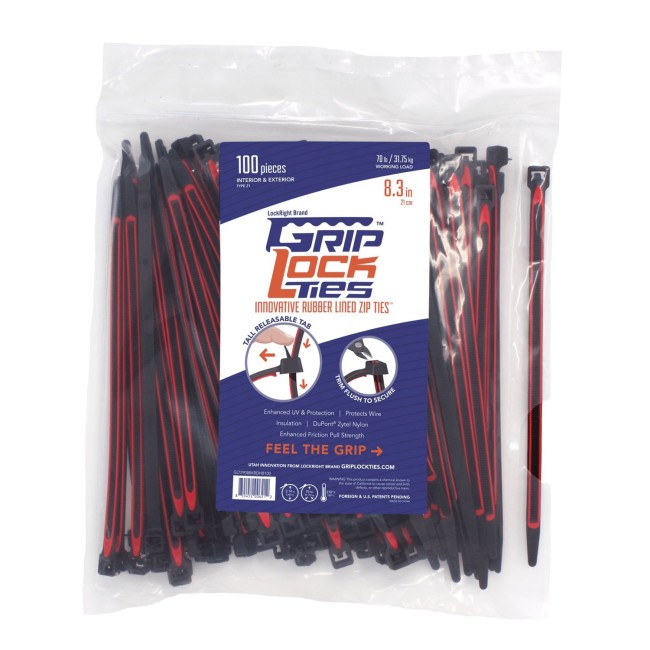
Cable ties are not the same as Grip Lock Ties. Rubber-lined and releasable, Grip Lock Ties can be used in applications that require durable materials and equipment (such as in the military) to secure connections. Including a flexible strap with serrated teeth and a ratcheting mechanism, how do Grip Lock Ties work?
- They are fastened by threading the serrated tooth end through the ratcheting mechanism.
- They are tightened by pulling the strap through the ratcheting mechanism. The teeth engage and prevent the belt from slipping.
- Once secure, you can customise the tension level by tightening the strap further. Grip Lock Ties stay in place once pulled.
Unlike cable ties, they prevent damage to wires, are rubber-lined, and handle extreme temperature fluctuations.
If you would like to learn more, read about the versatility of Grip Lock Ties, a comprehensive guide!
Advantages of Grip Lock Ties
Let’s look at some of the advantages of Grip Lock Ties and how they support your applications.
- Easy to install. Grip Lock Ties save industries on labour costs and can be tightened quickly without expensive tools! Some models are also reusable and adaptable for temporary installations or adjustments during field operations.
- Less expensive. When compared to bolts, screws, adhesive tapes, and P Clamps, Grip Lock Ties are economical for industries that need to secure materials in bulk.
- Materials are durable. Grip Lock Ties are able to meet the demands of any industry. Manufactured from Dupont Nylon and similar polymers, they eliminate stress and concentration points under tension. Soft rubber lining stops wires from being damaged by vibrations, radiation, chemical exposure, and high temperatures.
- UV protection. Grip Lock Ties can withstand extreme heat and pressure. For example, military vehicles can easily secure weapons without worrying about loosening.
- Enhanced strength and security. With a high tensile strength, Grip Lock Ties handle heavier loads such as securing equipment, wiring, or components in high-risk defence applications. With added grip mechanisms, Grip Lock Ties hold components securely even under movement and vibration. This ensures stability in vehicles, aircraft, and navy ships.
- Safer to use. Grip Lock Ties have non-conductive materials, so they are safe for applications near sensitive electrical systems or explosives. The smooth design of these ties also prevents damage to insulated wires and reduces the risk of short circuits (critical to communication and weapon systems).
- Versatile applications. In aerospace and vehicle maintenance, Grip Lock Ties secure cables, hydraulic lines, or other components in aircraft, ground, vehicles, and naval vessels. They can also manage wiring in advanced systems like radar, missile systems, and communication objects.
- Compliance with military standards. Grip Lock Ties are designed to meet military specifications (MIL-SPEC), so they are compatible with defence projects.
Although Grip Lock Ties are a solid pick for the defence industry, there are some potential disadvantages to consider.
- Grip Lock Ties are often more expensive (due to their advanced features), such as grip mechanism and material quality.
- If they are not quality controlled (and manufactured to exacting standards), defects such as weak locking mechanisms can compromise performance. In this case, it’s important to partner with a specialist who understands the logistics, such as AFT.
- Availability and supply chain risk. Sometimes, Grip Lock Ties may need longer lead times for production and delivery.
- For larger-scale projects needing thousands of ties, there is a cost difference you need to think about.
Comparing Performance: Cable Ties vs Grip Lock Ties
So, what cable tie should you choose for your application?
Think about the purpose of your project. Are you looking to secure cables or wires to a surface, or directly bundling and securing cables, hoses, or components?
What is the strength and load capacity? Cable ties can fail under heavy vibrations if the mount detaches from the surface, whereas Grip Lock Ties are more reliable in high-stress situations.
What level of environmental durability do you need? Cable tie may fail in high temperatures, while Grip Lock Ties can be used long-term.
How do they perform in defence applications? Cable tie mounts are suitable for fixed installations in controlled environments (such as base facilities or static systems), whereas Grip Lock Ties perform well in aircraft, vehicles, and field equipment where stability and durability are non-negotiable.
Are you looking to implement stainless steel grip ties? Understanding how harsh environments require the best in durability, Applied Fasteners and Tooling offer a range of cable ties to support electrical cables, network cables, or just harsh conditions out in the field.
Order Grip Lock Ties At Applied Fasteners and Tooling!
Applied Fasteners and Tooling was registered and AS9120 quality certified in 2014. It was founded to supply the aerospace and defence industries with specialised fastening products and technical support.
Emerging as a leader in the fastening system supply chain, AFT offers only the most innovative fastener technologies to push the boundaries of what is possible. Working with the design, procurement, production, quality, maintenance and repair, our customers depend on us as a reliable partner known for our responsiveness, collaboration, flexibility, and on-time delivery.
Contact us today to get a quote and to shop in stock our Grip Lock Ties, Honeycomb Inserts, Military Gaskets, Countersink Tooling, Motorsport Fasteners, Hi Lok Tooling, Cable Tie Mounts, Ball Lok Pins or Click Bond Fasteners!



